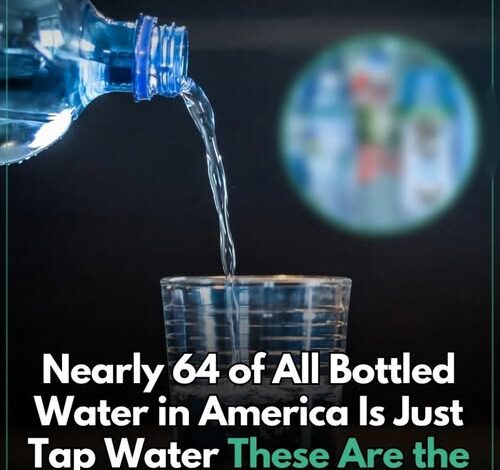
Study Finds Many US Bottled Water Brands Are Simply Tap
For decades, bottled water has been marketed as the cleaner, safer alternative to tap. Supermarket shelves are lined with dozens of brands, and millions of Americans grab a bottle every day without a second thought. The appeal is obvious: slick packaging, promises of purity, and the reassuring idea that what you’re drinking is better than what flows from your kitchen faucet. But research continues to reveal an inconvenient truth—much of that “premium” bottled water is nothing more than filtered municipal tap, sold back to consumers at prices hundreds of times higher than what they’d pay at home.
Studies suggest that nearly 64 percent of bottled water in the United States comes directly from municipal supplies. In other words, the same water filling your sink and shower is also what fills many of the bottles stacked in coolers at gas stations and grocery stores. Some companies put the water through additional purification processes before sealing it into bottles. Reverse osmosis, distillation, and microfiltration can improve clarity and taste. But not all brands bother with meaningful improvements. Many simply bottle municipal water with minimal treatment, slap a label on it, and market it as a lifestyle choice.
The illusion of superiority has real consequences. Major brands have faced scrutiny over contamination, undermining the very premise of bottled water as a safer option. Walmart’s Sam’s Choice and Giant’s Acadia, for example, were flagged for contamination levels that exceeded California’s health standards. On the flip side, companies like Nestlé Pure Life, Penta Ultra-Purified Water, and Gerber Pure have been recognized for transparency and the use of more rigorous purification techniques. Still, the fact that standards vary so widely across the industry underscores a bigger problem: bottled water is not as tightly regulated as most consumers assume.
In reality, municipal tap water in the U.S. is held to stricter oversight than bottled. The Environmental Protection Agency (EPA) requires frequent testing, comprehensive public reporting, and a set of standards that water systems must meet. By contrast, bottled water falls under the Food and Drug Administration (FDA), which enforces less frequent testing and weaker disclosure rules. That discrepancy means a bottle with a glossy mountain label might not be safer—or even cleaner—than the water coming from your faucet.
The risks don’t stop at regulation gaps. Independent testing has revealed troubling pollutants in bottled water samples, ranging from arsenic and bacteria to synthetic chemicals. One of the most alarming findings in recent years involves microplastics. Studies have shown that tiny plastic fragments often leach from bottles themselves or enter during the bottling process, meaning every sip could deliver invisible contaminants directly into your body. Microplastics are still being studied, but evidence suggests they may carry toxins and disrupt biological systems when ingested over time.
The environmental impact of bottled water adds another layer of concern. Americans consume billions of plastic bottles annually, and while recycling campaigns give the appearance of sustainability, the reality is far less reassuring. Recycling is energy-intensive, costly, and often ineffective. A large percentage of bottles never make it to recycling facilities at all, ending up in landfills or, worse, in oceans where they break down into the same microplastics now found in fish and, eventually, on our dinner plates. The fossil fuels burned to produce and transport those bottles contribute heavily to climate change, creating a chain of damage that extends far beyond individual households.
Even if recycling rates improved dramatically, the bigger issue is that bottled water is fundamentally unnecessary for most Americans. The vast majority of households already have access to safe, affordable tap water. In fact, municipal water systems are often required to meet higher safety standards than bottled water companies. When people spend hundreds or even thousands of dollars a year on bottled water, they’re not only wasting money—they’re also funding an industry that exploits public resources and damages the planet.
So why do so many people still reach for bottled water? Marketing is part of the answer. Companies know how to sell an image: crystal streams, snow-capped peaks, the illusion of untouched purity. Convenience is another factor. A sealed plastic bottle is easy to carry, and in places where water fountains are scarce, it feels like the only option. For many, bottled water also carries an unspoken status symbol—an accessory that seems cleaner, healthier, or more sophisticated than tap.
The truth, though, is far less glamorous. In most cases, tap water is not only cheaper but safer, more sustainable, and just as refreshing—especially with the addition of a basic home filter. A reusable stainless steel or BPA-free bottle can provide convenience without the environmental toll, and pairing it with a home filtration system offers the peace of mind many people seek when they opt for bottled water.
None of this is to dismiss genuine concerns about water safety. Communities across the U.S. have faced serious crises, from lead contamination in Flint, Michigan, to PFAS chemicals in drinking water near industrial sites. These failures erode public trust and drive people toward bottled options. But the solution lies in fixing and strengthening municipal systems, not abandoning them for an industry that is less regulated and far more damaging.
The lesson is clear: bottled water isn’t automatically better, cleaner, or safer. In fact, tap water is often subject to tougher standards and delivers the same or higher quality at a fraction of the cost. Add a filter, invest in a reusable bottle, and you not only protect your health but also help reduce the mountains of plastic waste choking ecosystems worldwide. For most Americans, the choice between tap and bottled isn’t really about water quality at all—it’s about perception. And the more people understand the reality, the easier it becomes to see bottled water for what it often is: expensive tap in a throwaway package.




